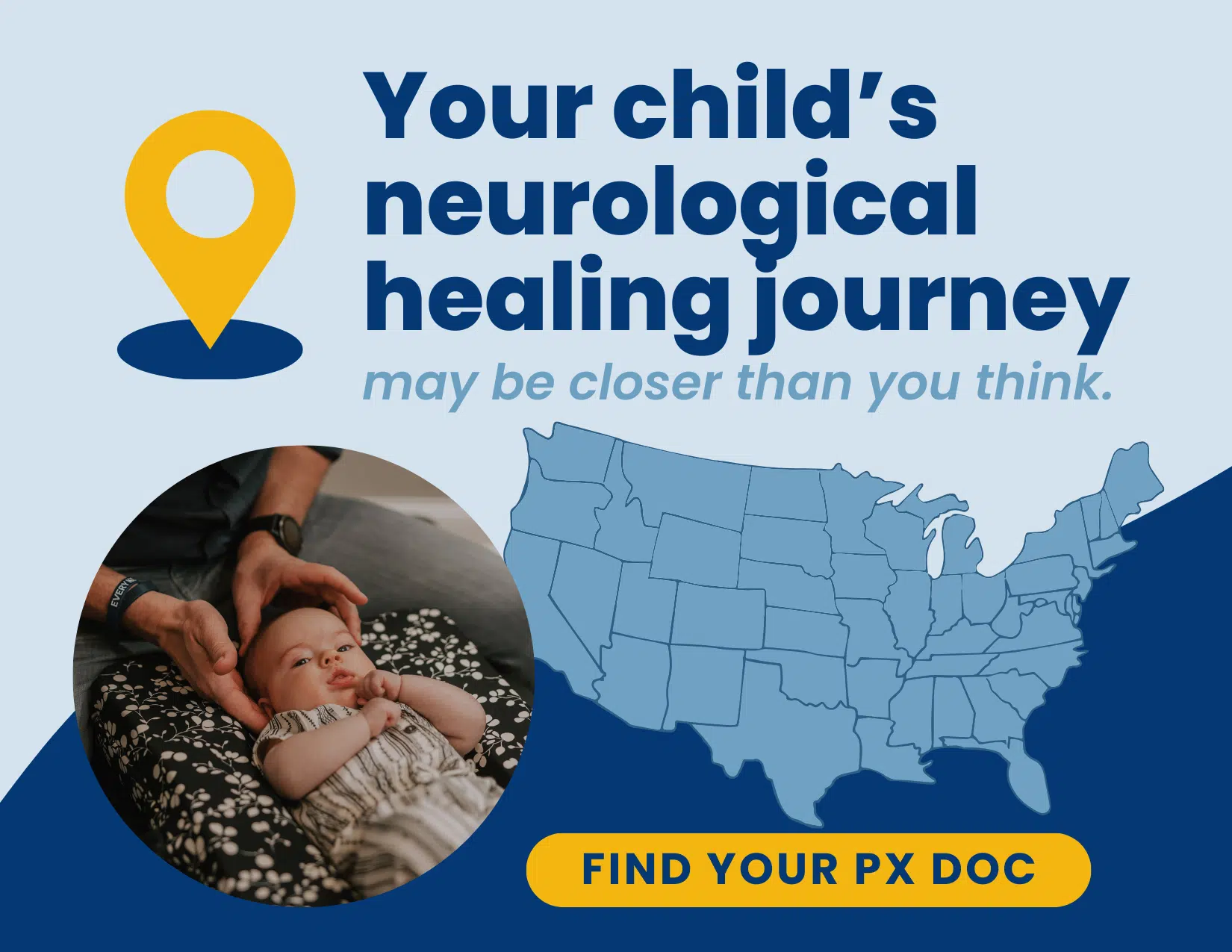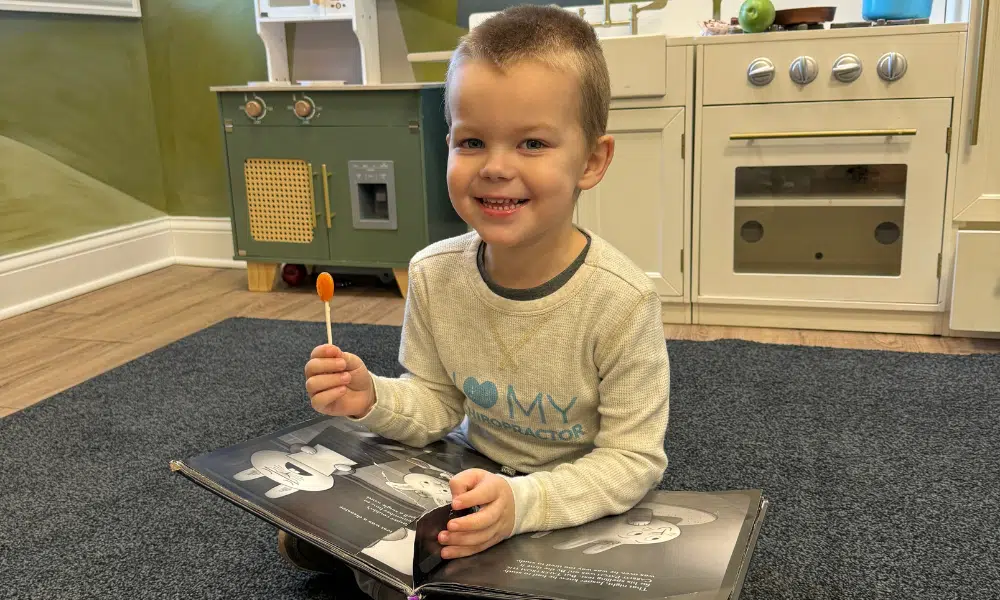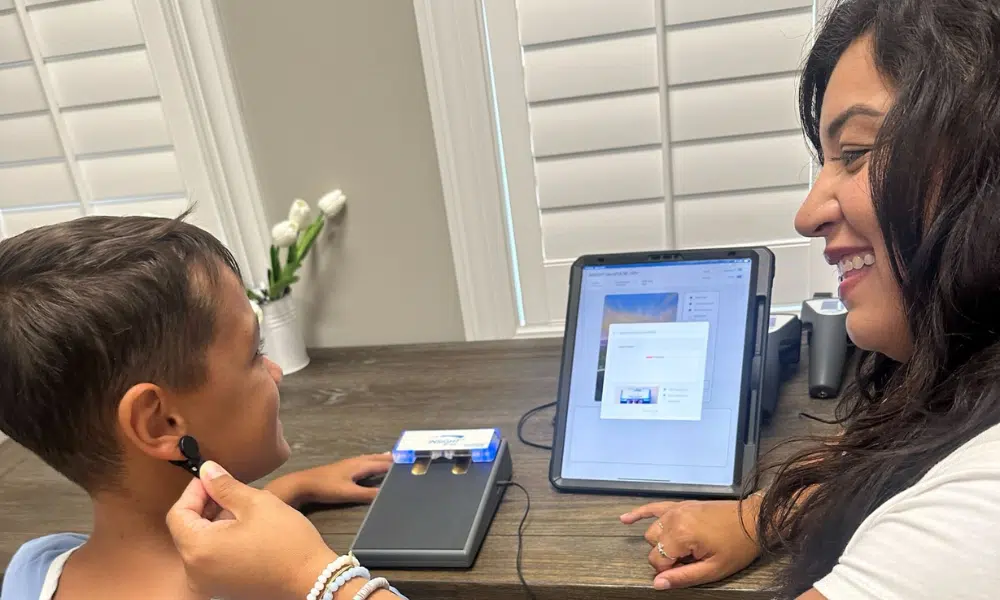Imagine this: Your once carefree, happy-go-lucky child suddenly becomes consumed by intense fears, obsessions, and compulsions. Virtually overnight, they start washing their hands raw, refusing to eat, or having severe meltdowns and panic attacks over the tiniest things. As a parent, you’re frightened, confused, and desperate for answers.
If this scenario sounds all too familiar, your child may be struggling with PANS (Pediatric Acute-Onset Neuropsychiatric Syndrome) or PANDAS (Pediatric Autoimmune Neuropsychiatric Disorders Associated with Streptococcal Infections). These closely related conditions cause a sudden onset of OCD-like behaviors, anxiety, and other neuropsychiatric conditions that can turn your family’s world upside down.
PANS and PANDAS are not as rare as you might think. Experts estimate these conditions affect as many as 1 in 200 children, causing significant disruptions to their physical health, emotional well-being, academic performance, and social functioning.
The rates of PANS/PANDAS related diagnoses and challenges have been exploding in recent years, as the “Perfect Storm” of higher levels of stress and toxicity hits our kids early and more often than ever before. Add in all the distress and challenges that hit our kids and families with the Covid lockdowns, chaos, vaccines, shedding, and so forth – and it’s easy to see why this severe neuro-immune condition is exploding in our pediatric and young adult population.
Desperate for solutions and knowing that this condition goes far beyond the capabilities of a conventional pediatrician, many families find themselves jumping from one medical specialist to another, with neurologists or immunologists often doing their best to explain things but still falling short. Armed with nothing but medications and pharmaceutical interventions, most cases try medication after medication with limited success.
From there, most families move on to what’s best known as functional or integrative medicine, spending thousands of dollars on advanced testing and lab work. Oftentimes, the results of all this testing show us what we already know – the nervous system, immune system, gut, endocrine, and core biological systems of the body are all out of balance, dysregulated, and dysfunctional.
Now, instead of a fistful of medications, most families are given a long list of vitamins, supplements, herbal remedies, homeopathic treatments, and detox kits. But still this approach tends to still feel like chasing symptoms and treating individual systems (ie. gut, immune, inflammation, etc.) versus a more comprehensive, foundational, root cause approach that takes nervous system dysregulation and dysautonomia head on. Many families feel the burden of this healing interventions overload both emotionally and financially, because while many see some positive changes with cleaning up their diet and working on gut health, most report that the significant neurological symptoms still persist despite all sorts of intervention in this holistic, natural health world.
At PX Docs, we offer a unique perspective on PANS/PANDAS, one that focuses on supporting and restoring balance to your child’s most critical system: nervous system regulation.
The nervous system controls and regulates every other important system of the body, with the interplay between the sympathetic and parasympathetic systems really being the key. The autonomic nervous system and vagus nerve are two of the most important things that PANS + PANDAS parents, patients, families, and even providers must understand at a deeper level, because they truly do hold the key to unlocking transformational healing in even the most difficult of chronic cases.
What is PANS/PANDAS?
PANS and PANDAS are pediatric neuropsychiatric symptoms characterized by the abrupt onset of Obsessive-Compulsive Disorder (OCD) or restrictive eating, along with other concerning signs. Studies have found that 5% of children with OCD fit the criteria for PANS/PANDAS. The criteria for a PANS diagnosis include:
- Sudden, acute onset of OCD or severe eating restrictions
- Concurrent presence of at least two other neuropsychiatric signs, such as:
- Anxiety
- Depression or mood swings
- Irritability or aggression
- Behavioral regression
- Sudden deterioration in school performance
- Motor or sensory abnormalities
- Somatic signs like sleep disturbances or urinary frequency
PANDAS is a subset of PANS Syndrome where the sudden onset of signs is specifically linked to a streptococcal infection. The five key diagnostic criteria for PANDAS are:
- Presence of significant obsessions, compulsions, and/or tics
- Abrupt onset and episodic (relapsing-remitting) course
- Onset between age three and puberty
- Association with streptococcal infection
- Association with other neuropsychiatric conditions (similar to PANS)
Children with PANS/PANDAS may exhibit a wide range of distressing traits that significantly interfere with their daily lives. They may have extreme separation anxiety, deterioration in handwriting and math skills, sensory processing sensitivities, and even hallucinations. Some kids become so consumed by contamination fears that they stop eating, rapidly losing weight. Others have severe behavioral regression, suddenly acting much younger than their age.
These alarming signs, and the speed with which they appear, often leave parents feeling frightened and overwhelmed. Many spend months searching for answers, pursuing costly specialist visits and medical tests. The emotional and financial toll on families cannot be overstated.
Acute PANS & PANDAS Flare Ups With Chronic Presentation
What makes caring for PANS/PANDAS so difficult is that the condition is both an acute issue and a chronic issue at the same time. The “flares” during growth spurts, immune challenges, and stressful seasons of life have acute-like challenges that need to be addressed. But it’s the chronic presence of subluxation, dysautonomia, and vagus nerve dysfunction that leads to the acute hypersensitivity and flare-ups in the first place.
To truly get transformational results that last, it’s essential that providers dig deep and address the foundational root causes of the chronic neurological dysregulation and exhaustion at play in PANS/PANDAS cases. Once you understand the progression of subluxation and dysregulation into pure neurological exhaustion and depletion, it becomes easier to understand why proper care and true results for these tough cases take a long time and have quite an up and down “roller coaster” type journey most of the time
The “Perfect Storm”: Triggers and Risk Factors
At PX Docs, we often use the term “Perfect Storm” to describe the events and environmental factors that can lead to the development of PANS/PANDAS. This concept recognizes that these conditions do not have a single cause but rather result from a complex interplay of triggers that overwhelm the nervous system, often as far back as during fetal and infant development periods.
One of the most well-known triggers for PANS/PANDAS is infection, particularly with Group A Streptococcus (the bacteria that cause strep throat). Many children experience a sudden onset of neuropsychiatric conditions following a strep infection, leading researchers to hypothesize that the immune system’s response to the infection may mistakenly attack the brain, causing inflammation and dysfunction.
However, strep is not the only infection that can trigger PANS/PANDAS. Other infections, such as influenza, Lyme disease, mycoplasma pneumoniae, and even the common cold, have been associated with trait onset or flare-ups. Environmental factors like exposure to mold, chemicals, or heavy metals may also play a role by disrupting immune function and neurodevelopment.
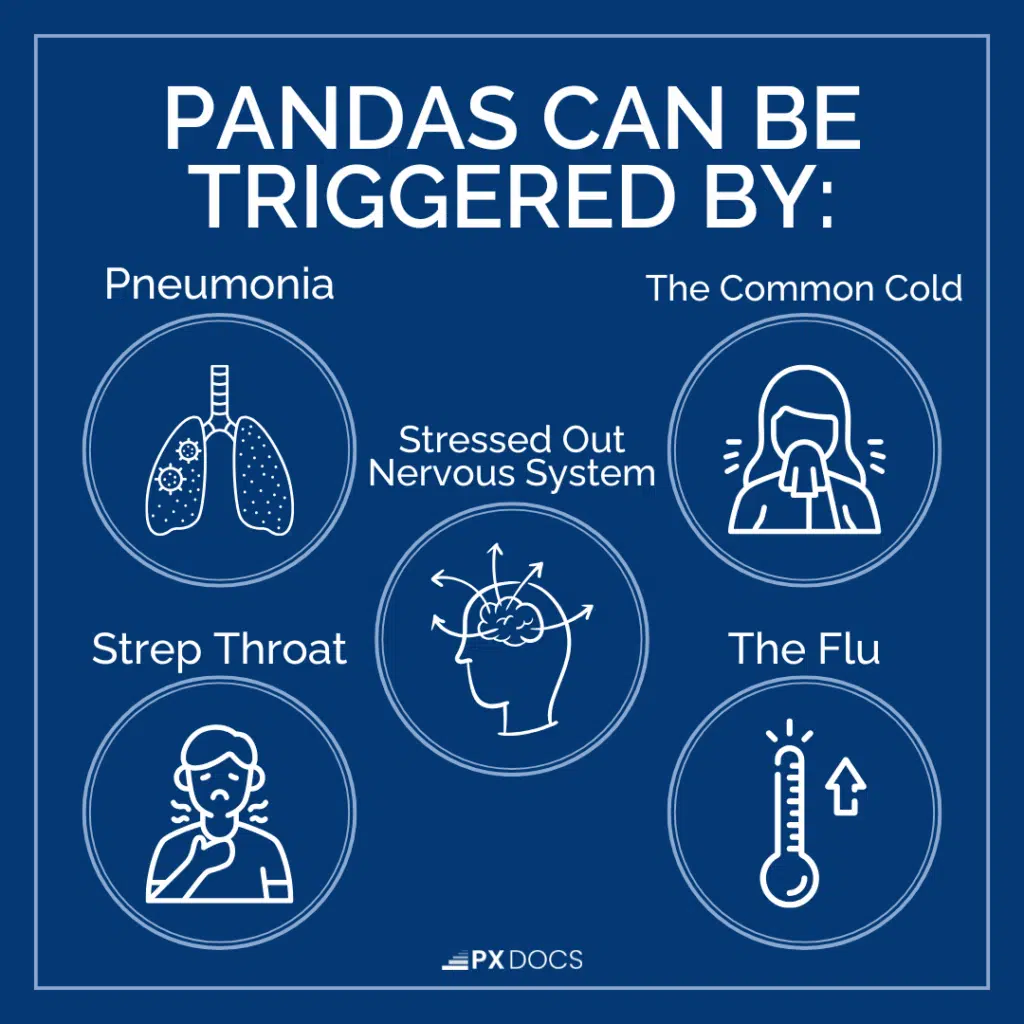
The “Perfect Storm” concept goes beyond just the acute triggers and looks even deeper beyond the strep or other infection, which may have ultimately been the “straw that broke the camel’s back,” instead of the original and only issue that triggered the storm.
The “Perfect Storm” scientific theory also encompasses the cumulative impact of early life stressors that could have led to damage and dysfunction within both the nervous system and immune system, leaving a child more susceptible to PANS/PANDAS. These stressors may include:
- Fertility + Perinatal Distress: Research has shown that maternal stress during pregnancy can impact fetal brain development, as can even earlier stress during the initial fertility journey that can lead to increased risk of autism and other neurodevelopmental disorders. This can prime the child’s nervous system for heightened reactivity to future stressors.
- Birth Interventions + Trauma: Complications during labor and delivery, such as prolonged labor, forceps or vacuum extraction, induction, or emergency C-section, can cause physical stress and even injury to the delicate tissues of the head and neck. This birth trauma may lead to subluxation, or interference and dysfunction within the brainstem region and nervous system, setting the stage for future nervous system dysregulation, delays, and so forth.
- Overuse of Toxins + Antibiotics: Factors like antibiotic overuse (which can disrupt the gut microbiome), toxins overload, poor nutrition, childhood illness or injury, and emotional stress or trauma can all contribute to a state of nervous system dysregulation.
When the “Perfect Storm” factors come together, they can lead to subluxation and dysautonomia—a condition characterized by an imbalance in the Autonomic Nervous System. This system regulates essential functions, including heart rate, digestion, and immune response. As a result of this underlying neurological imbalance, a child becomes more susceptible to acute triggers that can activate PANS/PANDAS traits.
Once again, we also know that the vagus nerve becomes a major player in this conversation as well. While we’ve always known the vagus nerve plays an important role in regulating heart rate, respiration, and digestion – we now know that it’s crucially connected to the modulation and suppression of inflammation, as well as behavioral and emotional regulation. Those are the core functions that go haywire with PANS/PANDAS, meaning that vagus nerve stimulation is perhaps the one intervention that holds the key to results with this complex condition, more so than anything else out there.
By understanding the multifactorial nature of PANS/PANDAS, we can approach these conditions more holistically. Rather than just suppressing signs or chasing individual triggers, we must address the underlying nervous system dysfunction and dysregulation that leaves a child susceptible in the first place.
This is where the PX Docs approach comes in and offers a more complete, foundational care option for families that they’ve often been up late at night searching for!
Conventional Medical Approaches and the PX Docs’ Perspective
The conventional medical approach to PANS/PANDAS primarily focuses on suppressing symptoms and caring for active infections. Doctors may prescribe psychiatric medications like antidepressants or antipsychotics to control OCD, anxiety, or aggression. Antibiotics are often used to care for strep or other bacterial infections that may be triggering signs. In severe cases, immunomodulatory therapies like IVIG or plasmapheresis may be recommended to suppress the overactive immune response.
While interventions can offer some relief for PANS/PANDAS, they often fail to address the root causes and may actually make the immune system dysfunction worse long-term. Medications may mask symptoms without correcting neurological imbalances, and repeated antibiotics can disrupt the gut microbiome, which is vital for brain health. We approach PANS/PANDAS not merely as an autoimmune issue, but as a result of nervous system dysregulation and dysautonomia. Our focus is on identifying and addressing the underlying neurological dysfunction that contributes to these symptoms.
The PX Docs’ Approach to Assessing and Addressing PANS/PANDAS
In children with PANS/PANDAS, the ANS is often stuck in a state of sympathetic dominance. The SNS is overactive, leading to chronic inflammation, anxiety, and digestive issues, while the PNS (and vagus nerve) is underactive, making it difficult for the body to relax, heal, and regulate itself. This imbalance, known as dysautonomia or dysregulation, can be triggered by subluxation. Lastly, subluxation and dysregulation are often first brought on by the sequence of early life stressors and triggers known as “The Perfect Storm” – discussed at length earlier in the article.
By addressing subluxation and supporting the proper function of the ANS and vagus nerve, PX Docs aim to restore balance to the nervous system as a whole. This approach recognizes that lasting healing from PANS/PANDAS requires more than just trait management or antibiotics. It requires identifying and addressing the underlying neurological imbalances that make a child susceptible to triggers in the first place.
Our approach to PANS/PANDAS begins with a thorough assessment of your child’s nervous system function. We use state-of-the-art INSiGHT scanning technology to objectively measure and visualize areas of neurological stress or imbalance that may be contributing to signs.
The INSiGHT scans include:
- Heart Rate Variability (HRV): This measures the balance and adaptability of the autonomic nervous system. Low HRV is often seen in children with PANS/PANDAS and indicates an overactive sympathetic response and underactive vagus nerve, indicating dysautonomia and dysregulation.
- Surface Electromyography (sEMG): This scan shows patterns of neuromuscular tension, asymmetry, and incoordination, helping us pinpoint areas of primary or major subluxation and nervous system dysfunction.
- Thermal Scanning: This measures skin temperature patterns that correlate with autonomic nervous system function and inflammation, helping us look even deeper into neuro-gastro-immune dysfunctions than things like labs or stool tests can.
PX Docs practitioners combine scans, health history, and physical exams to identify areas of your child’s nervous system needing support. This information helps create a personalized care plan targeting the root causes of dysfunction, focusing on Neurologically-Focused chiropractic adjustments to correct subluxations, reduce nerve interference, and restore nervous system regulation.
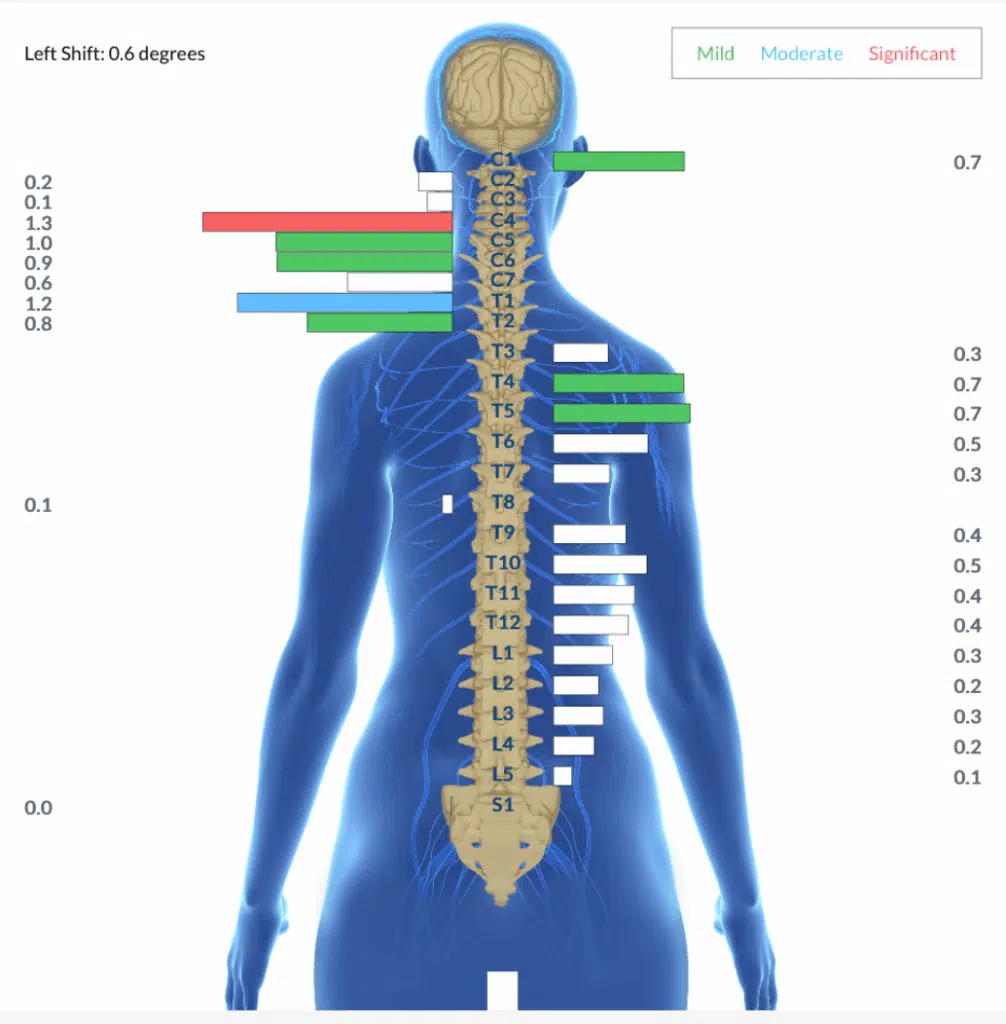
The NeuroThermal Scan above shows a classic subluxation pattern often seen in children struggling with chronic Neuro-Immune challenges like PANS/PANDAS. The “congested” areas of green, blue, and red indicate significant dysfunction right in the areas of immune system modulation, sinuses/throat, and inflammation regulation and control.
It’s important to remember that every child’s healing journey is unique, and there is no one-size-fits-all solution for PANS/PANDAS. In most cases, healing is a long, winding road with lots of ups and downs. To better understand the healing process and “rollercoaster” that can be PANS/PANDAS, please check out the podcast episode below.
The Neurologically-Focused approach is a partnership between practitioners, child, and family, with the shared goal of restoring your child’s vitality and potential. With compassionate support and a commitment to addressing the root causes of dysfunction, there is hope for recovery and a brighter future ahead!
Hope for Healing: You’re Not Alone
If you’re a parent struggling with your child’s PANS/PANDAS clinical diagnosis, know that you’re not alone. The fear, frustration, and overwhelm you feel are valid, but also know that there is hope, and there are providers who are ready to stand with you and fight for your child’s health and healing potential!
Like Lenny and other incredible stories of hope we share on our platform,
Our mission is to provide families like yours with the resources, support, and care you need to navigate this challenging journey. We believe that every child deserves the opportunity to thrive, and that true healing comes from empowering the body’s innate wisdom, not just masking traits.
If you’re ready to explore a different approach to your child’s PANS/PANDAS—one that addresses the root causes and helps build resilience for the future—we invite you to visit our directory and find a PX Docs practitioner near you. With their expertise in pediatric neurological care and commitment to a natural, holistic approach, they can help guide you toward a brighter tomorrow.
The path forward may not be easy, but you don’t have to walk it alone. With compassion, perseverance, and a willingness to look beyond the conventional paradigm, healing is possible.


